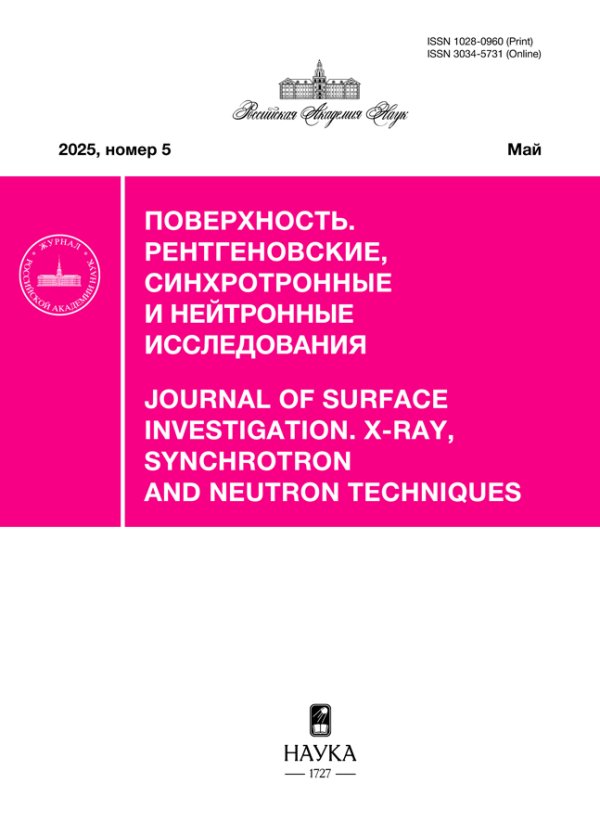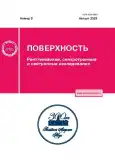Влияние подложки на спектры фотолюминесценции многослойных структур CaF2/Si
- Авторы: Величко А.А.1, Илюшин В.А.1, Крупин А.Ю.1, Филимонова Н.И.1, Руденко И.Е.1
-
Учреждения:
- Новосибирский государственный технический университет
- Выпуск: № 8 (2023)
- Страницы: 83-88
- Раздел: Статьи
- URL: https://journals.rcsi.science/1028-0960/article/view/137801
- DOI: https://doi.org/10.31857/S1028096023080150
- EDN: https://elibrary.ru/SHBPUE
- ID: 137801
Цитировать
Полный текст
Аннотация
В настоящей работе продемонстрирована фотолюминесценция от многослойных CaF2/Si структур, сформированных на поверхности подложек Si(111), Si(100) и SiO2/Si(100) при комнатной температуре c последующим отжигом. Обсуждено влияние структуры подложки на спектры фотолюминесценция. Исследования спектров фотолюминесценции многослойных CaF2/Si структур показали, что форма и положение максимумов зависят от типа подложки, несмотря на то, что сами многослойные структуры – толщина слоев и их количество – идентичны. Спектры фотолюминесценции образцов на монокристаллических подложках Si(100) и Si(111) похожи по форме и имеют близкие значения длин волн, соответствующих максимуму спектров фотолюминесценции. Положение максимумов спектров фотолюминесценции этих образцов соответствуют расчетам, полученным на основе эффекта квантового ограничения. В то же время формы спектров фотолюминесценции многослойной структуры на подложке из аморфного слоя оксида кремния резко отличаются от спектров образцов на монокристаллических подложках. Спектры фотолюминесценции образцов на аморфных подложках SiO2/Si(100) имеют два максимума. Сделано предположение, что механизмы зарождения нанокристаллов кремния и их последующая кристаллизация при отжиге на аморфных подложках SiO2/Si(100) радикально отличаются от условий формирования нанокристаллов кремния на монокристаллических подложках. Различие кристаллических структур поверхностей трех типов подложек создают различные условия для перекристаллизации при отжиге и, следовательно, приводят к различным свойствам как границ раздела данных гетероструктур, так и различным нанокристаллическим структурам слоев кремния. На основании полученных экспериментальных данных сделан вывод о влиянии кристаллографической структуры подложек на спектры фотолюминесценции.
Об авторах
А. А. Величко
Новосибирский государственный технический университет
Email: igor_rudenko.ru@mail.ru
Россия, 630073, Новосибирск
В. А. Илюшин
Новосибирский государственный технический университет
Email: igor_rudenko.ru@mail.ru
Россия, 630073, Новосибирск
А. Ю. Крупин
Новосибирский государственный технический университет
Email: igor_rudenko.ru@mail.ru
Россия, 630073, Новосибирск
Н. И. Филимонова
Новосибирский государственный технический университет
Автор, ответственный за переписку.
Email: ninafilimonova@ngs.ru
Россия, 630073, Новосибирск
И. Е. Руденко
Новосибирский государственный технический университет
Автор, ответственный за переписку.
Email: igor_rudenko.ru@mail.ru
Россия, 630073, Новосибирск
Список литературы
- Шик А.Я., Бакуева Л.Г., Мусихин С.Ф., Рыков С. // Физика низкоразмерных систем. Санкт-Петербург: Наука, 2001. 160 с.
- Saeta P.N., Gallagher A.C. // Phys. Rev. B. 1997. V. 55. № 7. P. 4563. https://www.doi.org/10.1103/PhysRevB.55.4563
- Zhang Q., Bayliss S.C., Hutt D.A. // Appl. Phys. Lett. 1995. V. 66. P. 1977. https://www.doi.org/10.1063/1.113296
- Photopoulos P., Nassiopoulou A.G., Kouvatsos D.N., Travlos A. // Mater. Sci. Engineer. 2000. V. 69. № 70. P. 345. https://www.doi.org/10.1016/s0921-5107(99)00402-x
- Cho E.-C., Green M.A., Corkish R., Reece P. // J. Appl. Phys. 2007. V. 101. P 024321. https://www.doi.org/10.1063/1.2430919
- Гусев О.Б., Поддубный А.Н., Прокофьев А.А., Яссиевич И.Н. // ФТП. 2013. Т. 47. № 2. С. 147
- Canham L. // Faraday Discussions. 2020. V. 222. P. 10. https://www.doi.org/10.1039/d0fd00018c
- Okamoto Sh., Kanemitsu Y. // Solid Siate Comm. 1997. V. 103. № 10. P. 573. https://www.doi.org/10.1016/S0038-1098(97)00227-5
- Araya M., Diaz-Droguett D.E., Ribeiro M. et at. // J. Non-Cryst. Solids. 2012. V. 358. Iss. 5. P. 880. https://www.doi.org/10.1016/j.jnoncrysol.2011.12.072
- Watanabe M., Matsunuma T., Maruyama T., Maeda Y. // Jpn. J. Appl. Phys. 1998. V. 37. P. 591. https://www.doi.org/10.1109/APEIE.2018.8545494
- Maruyama T., Nakamura N., Watanabe M. // Jpn. J. Appl. Phys. 2000. V. 39. P. 1996. https://www.doi.org/10.1143/jjap.39.1996
- Velichko A.A., Ilyushin V.A., Krupin A.Y., Filimonova N.I. // Rus. Phys. J. 2021. V. 64. № 2. P. 198. https://www.doi.org/10.1007/s11182-021-02316-3
- Velichko A.A., Ilyushin V.A., Krupin A.Y., Filimonova N.I. // J. Surf. Invest.: X-Ray, Synchrotron Neutron Tech. 2021. № 5. P. 13. https://www.doi.org/10.31857/S102809602103016X
- Величко А.А., Илюшин В.А., Крупин А.Ю., Гавриленко В.А., Филимонова Н.И. // Поверхность. Рентген., синхротр. и нейтрон. исслед. 2016. № 9. С. 33. https://www.doi.org/10.7868/S020735281609016X
- Zhu X., Lu J., Gao Y. et al. // J. Appl. Phys. 2017. V. 56. P. 020305. https://www.doi.org/10.7567/JJAP.56.020305
- Pauc N., Calvo V., Eymery J. et al. // Opt. Mater. 2005. V. 27. P. 1000. https://www.doi.org/10.1016/j.optmat.2004.08.052
- Botas A.M.P., Anthony R.J., Wu J. et al. // Nanotechnol. 2016. V. 27. P. 325703. https://www.doi.org/10.1088/0957-4484/27/32/325703
- Lacona F., Franzo G., Spinella C. // J. Appl. Phys. 2000. V. 87. № 3. P. 1296. https://www.doi.org/10.1063/1.372013
- Araya M., Diaz-Droguett D.E., Ribeiro M. et at. // J. Non-Cryst. Solids. 2012. V. 358. P. 880. 10. https://www.doi.org/1016/j.jnoncrysol.2011.12.072
- D’Avitaya A., Vervoort L., Bassani F. Ossicini S., Fasolino A., Bernardini F. // Europhys. Lett. 1995. V. 31. № 1. P. 25. https://www.doi.org/10.1209/0295-5075/31/1/005
- Величко А.А. Разработка технологии оптоэлектронных МС на гетероструктурах полупроводник– (Ca,Sr,Ba)F2–полупроводник: Дис. ... д-ра технических наук: 01.04.10. Новосибирск: НГТУ, 1999. 372 с.
- Бурдов В.А. // ФТП. 2002. Т. 36. № 10. С. 1233.
Дополнительные файлы














